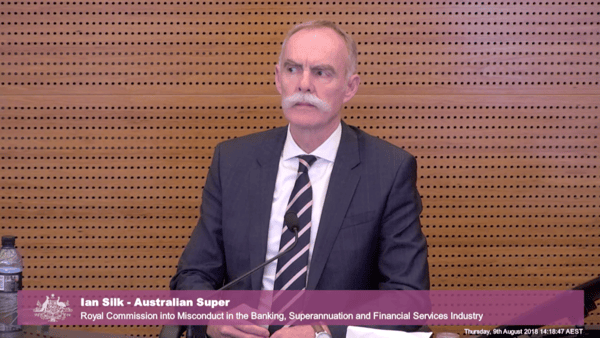Crisis Management Royal Commission Watch - Part 3
Why complexity and opacity can be the enemy - and when short-term momentum can cause long-term damage

This week in numbers:
- Over 50 times - NAB's Paul Carter answered with some variation of "I don't recall"
- 178 online articles this week mentioned the 'dark' or 'darkness' of the industry
- 0 customers affected took the stand
As we make sense of the task ahead for the industry - restoring trust - we’ll share our observations as communicators. There’s no silver bullet fix, but there are ways to stop, or slow, the reputational crisis.
What a difference a month makes. The Commission is back with Round 5 on superannuation, and the difference from the previous round could not be more marked.
While the plight of farmers gripped the nation’s hearts and minds in Round 4, there’s been nothing gripping about this week’s dry and detailed “war of attrition”.
It’s not just that coverage has particularly dropped off in volume. Media and public appetite for the cut and thrust has waned dramatically, as evidenced by the rote reporting and lack of distinguishing headlines or rallying cries familiar in previous rounds.
In fact, those pitiable figures forced to ‘sit in the back row of a stiflingly warm courtroom…trying to discern what's going on’ have griped increasingly openly about the simultaneous boredom and difficulty of faithfully depicting the proceedings.
So anaesthetised by the tedium and complexity have the media become, that they’ve turned to reporting on the challenges faced by recruiters today; contemplating Thorburn’s pinstripes, Kelaher’s pocket squares and Silk’s moustache; and even describing their own routines.
Hardly surprising for a round with no case studies and “trolleys full of binder books.”
This is welcome news for some – the quieter the better – while others have warned of the dangers of turning away. The Age said that “Australia’s biggest financial swindle” was unfolding in plain sight, saying that “if you have no idea what I’m talking about, or lack the desire to understand the detail to follow, it’s even more likely that you’re caught up in it. And if you tune out again now, you’ll miss…an opportunity for…financial redress.”
Shot to the foot
But perhaps the settling dust has its upsides. For one, it lessens the risk of ScoMo’s threatened “own goal”. (The latest one, that is – not the “own goal” by trade wars he cautioned against last month).
There have been heavy casualties in the Commission so far – not least a deterioration of public trust in the system and its institutions – and the toll will only rise as it continues. Rightly so many would say; it’s time to pay the piper. But others (arguably with motive) have been able to take a more moderate tone this week – thanks in part to the lack of case studies.
Without the relatable and emotive faces reminding us of the human impact, the dialogue has been able to move into a far more sterile and logical space – one that allows for voices saying “We don’t want to get carried away… [or] throw the banking baby out with the bathwater. It’s a step too far.” Such comments would have been fatal in the first week of July.
Many continue to see tightening credit, profit dives, falling house prices, and other macros blamed in large part on the Commission, as harbingers of a market shift that could have significant knock-on effects to consumers. Some looking ahead at the longer-term consequences of community anger and loss of confidence see a future where those currently being vindicated end up paying a hefty price.
Just as Haynes raised the question of criminal conduct, the Greens seized the moment to launch their message that it is “time to break up the banks”. Their language had all the evocative decaying mortality of Metaphysical poets, with the “rot”, toxicity and “cancer at the heart” of the financial system.
They spoke of the rotten foundations of our banking and financial system – but even those who agree with them must also concede that it’s very hard to keep anything up if you remove all the foundations at once.
Hayne has a responsibility – he redrew the lines in the sand to remind Australia that he is not there to advance victims’ interests, air all the case studies, or rule on law breaking, but to find out the truth of “what was done or not done”. But does he also have an – at times potentially conflicting – fiduciary responsibility to the overall structure and stability of the system? And where does this trump his more overt role?
Heart of Darkness
From overt to covert - if there is one theme that did manifest this week, it was that of suspicious secrecy. Hodge started us off on Monday by asking “What happens when we leave these trustees alone in the dark with our money?...Consumers are unable to do anything more than peer dimly through the darkness of their superannuation trustees…[with] no dedicated and active conduct regulator shining a spotlight on the trustees and searching out bad behaviour”.
Not for the first time, Hodge’s imagery found roots, with illustrations of an ‘opaque’, ‘sinister’, and ‘murky’ industry ‘shrouded in darkness’, keeping members in the dark about ‘the dark art’ and ‘true dark heart’ of it, while Hodge is credited with “peeling back the details” and “shining a light”.
Bad timing for NAB’s “bid for secrecy” on documents.
Though revitalised, this language isn’t new to the Commission. The balance of opacity and transparency, simplified to dark and light, has been mentioned before, e.g. with the AFR’s contention that “some funds are beacons of light but there are still too many that are opaque’, and ScoMo’s glee over ‘a rather large spotlight shining on the misconduct within our banks’.
Darkness has always been a cypher for enemy, fear, blindness and misbehaviour, while light is clean, pure and revealing. It’s not always objectively true, but the binary is powerful enough that assumption will overtake.
What does this mean for corporate comms?
Simplicity works, transparency works. It’s not enough, as superfunds and others affected by reputational damage and stakeholder mistrust move forwards, to have nothing to hide. You must also – consistently, clearly, candidly – communicate. The structure of products, the nature of the business, the application of fees, must be understandable and accessible. Even given necessary complexity in the system must be explained to the stakeholder – and especially the consumer.











